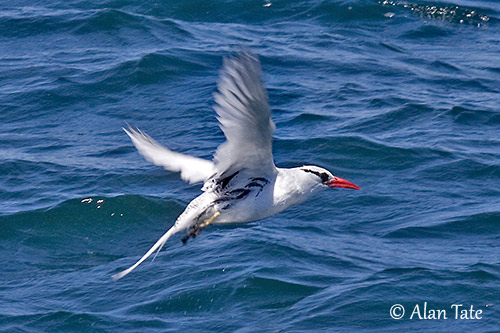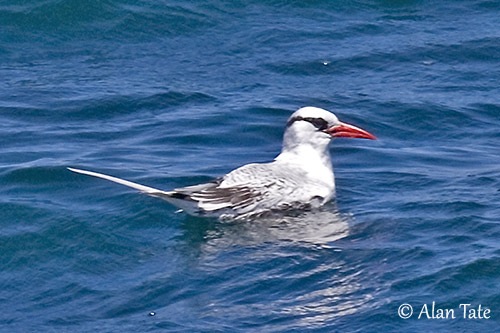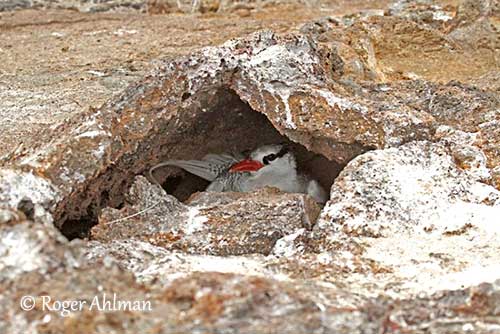
Red-billed Tropicbird
Phaethon aethereus
Phaethontiformes Order – Phaethontidae Family
BIOMETRICS:
Length: 90-105 cm
Wingspan: 100-110 cm
Weight: 420 g
LONGEVITY: up to 10 years
BEHAVIOUR:
Red-billed tropicbird catches its preys by hovering, and then plunge-diving, generally only into surface layer. It inspects ships but does not follow them.
It’s generally solitary or in pairs away from breeding colonies. It seats buoyantly on water with tail half-cocked to keep it dry.
These birds stay most of time in the air. Courtship display occurs in flight. Several birds fly close each others, uttering loud calls and flying as fast wingbeats as long down glides, with their long tail feathers downwards. Strong disputes break out between males to protect their mates and nest areas.
Colonies located on islands consist of several hundreds of breeding pairs.
No regular migration is observed. We can see an extensive dispersal, especially of juveniles, often over water fairly near breeding areas. Some adults can be seen vicinity of colonies all year round.
FLIGHT:
Red-billed tropicbird flies well above surface with direct, rather pigeon-like flight action, often interspersed with long glides. Often soar high into sky. Its elongated central tail feathers curl and undulate in flight. They have an acrobatic flight when pursue flying fishes.
REPRODUCTION:
Red-billed tropicbird nests in a hole or in a crevice, on the bare ground.
Female lays one white egg, spotted red-brown. Incubation lasts about 40 to 46 days, by both parents, but female most of time, while the male feeds her. Chick hatches with grey down. It stays alone at nest while parents search for food. Parents feed the chick twice every three days, until fledging, 12 or 13 weeks after hatching. Young are not able to fly, and stay on the water several days, loosing weight until they can soar in the air.
DIET:
Red-billed tropicbird feeds on fish, especially flying fish, and squid.
PROTECTION / THREATS / STATUS:
Red-billed tropicbird is probably the less numerous of tropicbirds, but population is not globally threatened.
Fr: Phaéton à bec rouge
All : Rotschnabel-Tropikvogel
Esp: Rabijunco Etéreo
Ital: Fetone beccorosso
Nd: Roodsnavelkeerkringvogel
Russe: Фаэтон красноклювый
Sd: Rödnäbbad tropikfågel
Photographers:
Roger Ahlman
Pbase Galleries Peru and Ecuador
Alan & Ann Tate
AA Bird Photography
Text by Nicole Bouglouan
Sources :
HANDBOOK OF THE BIRDS OF THE WORLD vol 1 by Josep del Hoyo-Andrew Elliot-Jordi Sargatal - Lynx Edicions - ISBN: 8487334105
Wikipedia, the free encyclopaedia
CREAGUS@Monterey Bay (Don Roberson)
Bird Friends of San Diego County (Audubon Society)

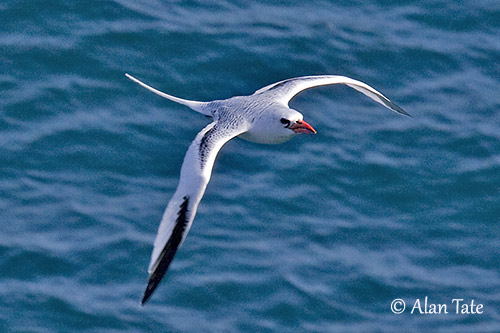
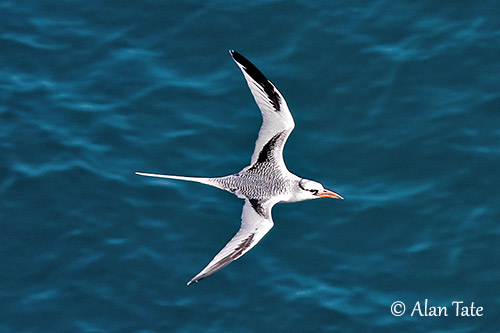
We can find 3 subspecies that differ in size and to lesser extent in plumage.
Phaeton.a. aethereus (described above) is found in S Atlantic Ocean.
Phaeton.a. mesonauta occurs in E Pacific, Caribbean and E Atlantic.
This race has rosy flush in fresh plumage. The black markings are more solid and extend to the median-coverts. The barring on the upperwing is more conspicuous.
Phaeton.a. indicus is found in Persian Gulf, Gulf of Aden, Red Sea.
This one is smaller, with restricted mask often extending behind the eye. The bill is more orange with narrow, black cutting edges.
VOICE: SOUNDS BY XENO-CANTO
Red-billed tropicbird’s typical calls are loud, piercing, shrill, but grating whistles and crackles, often given in rapid series when in display flight at colony.
HABITAT:
Red-billed tropicbird breeds in large holes and crevices, or under boulders on rocky offshore islands, in tropical and subtropical seas. It prefers inaccessible spot on cliff, where takeoff is relatively easy. It’s Pelagic away from breeding colonies.
RANGE:
Tropical Atlantic, eastern Pacific, North-western Indian Ocean.
